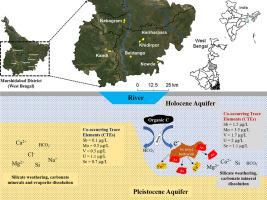当前位置:
X-MOL 学术
›
Appl. Geochem.
›
论文详情
Our official English website, www.x-mol.net, welcomes your feedback! (Note: you will need to create a separate account there.)
Mobilization of co-occurring trace elements (CTEs) in arsenic contaminated aquifers in the Bengal basin
Applied Geochemistry ( IF 3.4 ) Pub Date : 2020-11-01 , DOI: 10.1016/j.apgeochem.2020.104709 Michael A. Vega , Harshad V. Kulkarni , Karen H. Johannesson , Robert J. Taylor , Saugata Datta
Applied Geochemistry ( IF 3.4 ) Pub Date : 2020-11-01 , DOI: 10.1016/j.apgeochem.2020.104709 Michael A. Vega , Harshad V. Kulkarni , Karen H. Johannesson , Robert J. Taylor , Saugata Datta

|
Abstract The mobilization of co-occurring trace elements (CTEs) in aquifers with known metal (loid) contamination may exacerbate potential human health threats where release mechanisms are not geochemically limited. This study investigates the co-mobilization of the potentially toxic CTEs antimony (Sb), molybdenum (Mo), vanadium (V), uranium (U), and selenium (Se) with arsenic (As) and iron (Fe) in contrasting high and low As aquifers surrounding the river Bhagirathi in Murshidabad, West Bengal, India. We sought to determine the dominant release mechanisms and fate of each CTEs as they relate to redox conditions, major element dissolution pathways, and characteristics of dissolved organic matter (DOM). Groundwater samples collected in 2013 and 2015 field campaigns across six villages in the Murshidabad district were analyzed for major and trace elements, as well as the quantity and optical properties of DOM. East of the river Bhagirathi, the Holocene aquifer contains groundwater with compositions reflective of carbonate mineral dissolution and silicate mineral weathering, along with clear signs of Fe reduction and associated mobilization of As, Sb, Mo, V, and U. Relatively oxic groundwater in the Pleistocene aquifer underlying the study sites on the west side of the river showed minimal Fe reduction and signatures of carbonate mineral dissolution and silicate mineral weathering (i.e. Nabagram), or evaporite mineral dissolution (i.e. Kandi). In groundwater samples from the more oxic Pleistocene aquifer, concentrations of As, Sb, Mo, and V were substantially lower than in the Holocene aquifer, however, U concentrations were relatively higher where carbonate mineral dissolution predominated (i.e., Nabagram). Compelling positive correlations between Fe and CTEs in the Holocene but not in the Pleistocene aquifer implicated Fe reductive processes as the probable pathway for CTEs release. The presence of humic-like DOM ligands and inorganic ions (i.e., Ca2+, CO32−) may also enhance CTEs mobility via aqueous complexation reactions, or possibly by inhibiting CTEs adsorption. We further hypothesize that carbonate mineral dissolution mobilizes U in the absence of Fe reduction, and that U solubility in the reducing Holocene aquifer may be facilitated by carbonate mineral dissolution products (e.g., Ca, HCO3−, CO32−) that promote U complexation and the inhibition of (bio)immobilization pathways. Conclusively, potentially toxic CTEs are being mobilized concomitantly with As in the Murshidabad district of West Bengal, probably by microbial Fe reduction. Because these aquifers still contain requisite organic matter and bulk sediment Fe required for Fe reductive processes, it follows that concentrations of CTEs may increase in the future. We therefore argue that – despite moderately low concentrations of CTEs in the current study – mechanistic modeling efforts and more extensive monitoring of trace metal (loid)s should be performed to ensure that drinking water supplies do not pose additional health threats in the coming years.
更新日期:2020-11-01

























 京公网安备 11010802027423号
京公网安备 11010802027423号